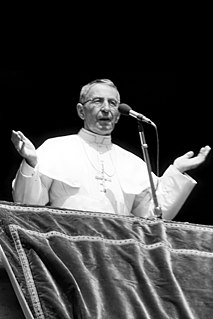
Pope John Paul I was head of the Catholic Church and sovereign of the Vatican City from 26 August 1978 to his death 33 days later. He was the first pope born in the 20th century and the last one to die in the 20th century. His reign is among the shortest in papal history, resulting in the most recent year of three popes and the first to occur since 1605. John Paul I remains the most recent Italian-born pope, the last in a succession of such popes that started with Clement VII in 1523.

Pope Benedict XV, born Giacomo Paolo Giovanni Battista della Chiesa, was head of the Catholic Church from 1914 until his death in 1922. His pontificate was largely overshadowed by World War I and its political, social, and humanitarian consequences in Europe.

A guardian angel is a type of angel that is assigned to protect and guide a particular person, group or nation. Belief in tutelary beings can be traced throughout all antiquity. The idea of angels that guard over people played a major role in Ancient Judaism. In Christianity, the hierarchy of angels was extensively developed in the 5th century by Pseudo-Dionysius the Areopagite. The theology of angels and tutelary spirits has undergone many changes since the 5th century. The belief is that guardian angels serve to protect whichever person God assigns them to.

The Prayer to Saint Michael the Archangel usually refers to one specific Catholic prayer to Michael the Archangel, among the various prayers in existence that are addressed to him. It falls within the realm of prayers on spiritual warfare. From 1886 to 1964, this prayer was recited after Low Mass in the Catholic Church, although not incorporated into the text or the rubrics of the Mass.

The Roman Rite is the primary liturgical rite of the Latin Church, the largest of the sui iuris particular churches that comprise the Catholic Church. It developed in the Latin language in the city of Rome and, while distinct Latin liturgical rites such as the Ambrosian Rite remain, the Roman Rite has gradually been adopted almost everywhere in the Latin Church. In medieval times there were numerous local variants, even if all of them did not amount to distinct rites, yet uniformity increased as a result of the invention of printing and in obedience to the decrees of the Council of Trent of 1545–63. Several Latin liturgical rites that survived into the 20th century were abandoned voluntarily after the Second Vatican Council. The Roman Rite is now the most widespread liturgical rite not only in the Latin Church but in Christianity as a whole.

Matthew 6:8 is the eighth verse of the sixth chapter of the Gospel of Matthew in the New Testament and is part of the Sermon on the Mount. This verse continues the discussion on the proper procedure for praying.
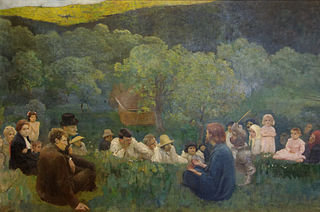
Matthew 6:25 is the twenty-fifth verse of the sixth chapter of the Gospel of Matthew in the New Testament and is part of the Sermon on the Mount. This verse shifts the discussion from one of money to one of worry.

Matthew 7:7–8 are the seventh and eighth verses of the seventh chapter of the Gospel of Matthew in the New Testament and is part of the Sermon on the Mount. These verses begin an important metaphor generally believed to be about prayer.
During his papal tenure, Pope Benedict XVI focused on building on the outreach of his predecessors towards Islam, particularly on the efforts of Pope John Paul II, who experts say established trust and opened opportunities for dialogue with Muslims. One of the important milestones in the Pope's efforts included a religious and peaceful initiative called A Common Word. This was provoked by an ill-conceived 2006 lecture he delivered at a university in Regensburg, Germany, which prompted Muslim leaders to gather and make overtures to their Christian and Jewish counterparts. Later on, Pope Benedict pursued key initiatives that helped foster Christian and Muslim dialogue. These were founded on the Pope's belief that Christians and Muslims have shared religious experience and that Christianity and Islam are both theologically founded in "God's irruptive call ... heard in the midst of man's ordinary daily existence."
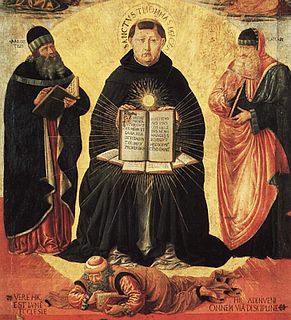
This article contains a selection of thoughts of Thomas Aquinas on various topics. It is not intended as a complete account of Aquinas's thought. Within Aquinas' thought is included the philosophical school of Thomism.
Summorum Pontificum is an apostolic letter of Pope Benedict XVI, issued in July 2007, which specified the circumstances in which priests of the Latin Church could celebrate Mass according to what he called the "Missal promulgated by Blessed John XXIII in 1962", and administer most of the sacraments in the form used before the liturgical reforms that followed the Second Vatican Council.

Mental prayer is a form of prayer recommended in the Catholic Church whereby one loves God through dialogue, meditating on God's words, and contemplation of Christ's face. It is distinguished from vocal prayers which use set prayers, although mental prayer can proceed by using vocal prayers in order to improve dialogue with God. The practice of mental prayer aligns with that of vocal prayer, as prayer has traditionally been defined as "the raising of one's mind and heart to God."
Good Friday Prayer can refer to any of the prayers prayed by Christians on Good Friday, the Friday before Easter, or to all such prayers collectively.
Auspicia quaedam is an encyclical of Pope Pius XII on worldwide public prayers to the Virgin Mary for World peace and the solution of the problem of Palestine, given at Rome at St. Peter's, the first day of May of the year 1948, the tenth of his Pontificate
The Church policies after World War II of Pope Pius XII focused on material aid to war-torn Europe, the internationalization of the Roman Catholic Church, its persecution in Eastern Europe, China and Vietnam, and relations with the United States and the emerging European Union.
Veritatem facientes is an apostolic letter of Pope Pius XII to the Catholic faithful of Romania, protesting against their persecution and the virtual eradication of the Catholic Church in their country. The letter asks for courage and prayers.
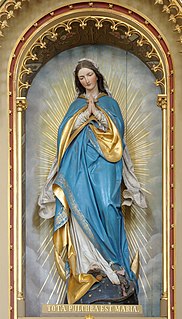
The Mariology of the popes is the theological study of the influence that the popes have had on the development, formulation and transformation of the Roman Catholic Church's doctrines and devotions relating to the Blessed Virgin Mary.
Communium interpretes dolorum is an encyclical by Pope Pius XII at the ending of World War II in Europe, appealing for prayers for peace during May, given at Rome, at St. Peter's on Sunday 15 April 1945, in the seventh year of his pontificate.
The canonization process of Pope Pius XII dates to shortly after his death in 1958. He was declared a servant of God in 1990 and venerable in 2009. Father Peter Gumpel is currently the relator of Pius XII's cause for canonization. The potential beatification of Pius XII has raised concern, especially by Jewish organisations, because of his controversial record during the Holocaust. The objections especially arise because of the refusal by the Vatican to allow independent access to the Vatican's archives for the period of Pius XII's papacy.
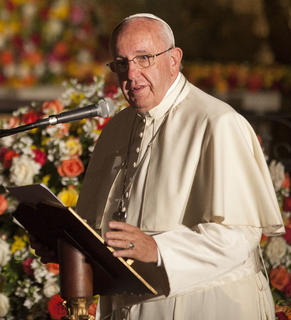
Elected on 13 March 2013, Francis is the first member of the Society of Jesus to be appointed pope and the first non-European to hold the office since the 8th century. He described his papal name as pointing to what he wants to emulate in Saint Francis of Assisi: to have a poor church, for the poor, always going out to the margins, and to show concern for the natural environment. His papal motto Miserando atque eligendo contains a central theme of his papacy, God's mercy, which has led to conflict with traditionalists on issues such as reception of Communion by remarried Catholics. In addressing real life situations he often appeals directly to Jesus's emphases, in continuity with the Second Vatican Council which showed a renewed emphasis on the New Testament sources of Catholic teaching. He has placed greater emphasis on church synods and on widespread consultation and dialogue, uplifting the roles of laypersons and of women in the Catholic church and criticizing clericalism.











